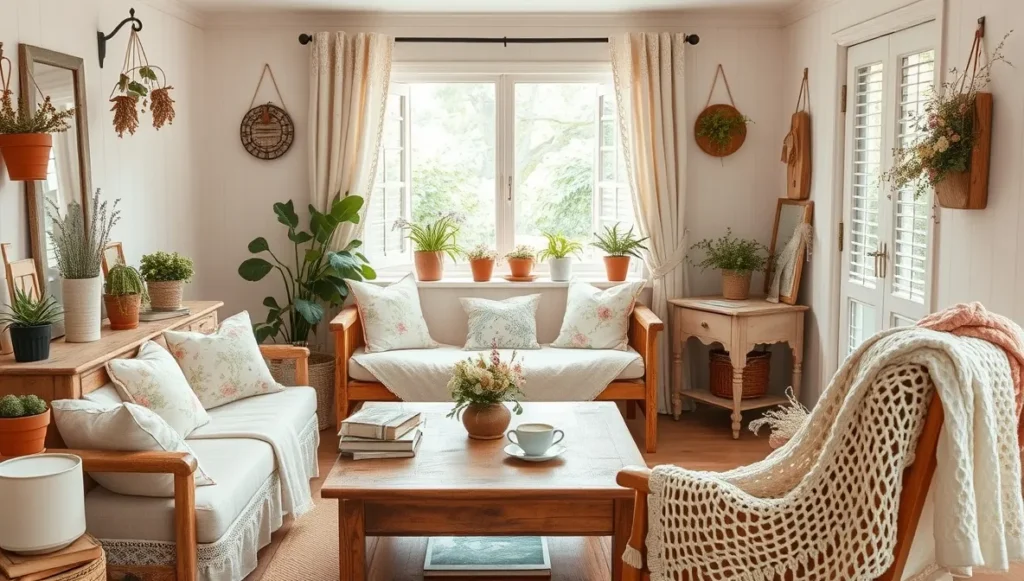- Why Vintage Interior Design Still Has My Heart - September 3, 2025
- Still in Love with Traditional Design – And Here’s Why - September 3, 2025
- The Enduring Charm of English Country Design: Why This Style Never Goes Out of Fashion - September 2, 2025
Table of Contents
Last week, a client asked me why I keep pushing “that cottage thing” when clean lines and white walls are still trendy. Here’s the thing – I’ve been doing this long enough to watch design fads come and go. Cottagecore isn’t going anywhere because it taps into something we’re all craving: homes that actually feel like home.
I started noticing the shift around 2019. Clients were getting tired of their Instagram-perfect spaces. “It’s beautiful,” they’d say, “but I’m afraid to actually live in it.” That’s when I knew something had to change.
What Cottagecore Really Means (Spoiler: It’s Not About Perfection)
Forget what Pinterest tells you. Real Cottagecore design is messy in the best possible way. It’s about choosing the wooden spoon with knife marks over the pristine silicone one. It’s keeping books you’ll never read again just because they look right on that wonky shelf you found at an estate sale.
I’ve been calling it “purposeful imperfection” in my consultations. Sounds fancy, but it just means embracing the stuff that makes your space yours. That chip in your favorite mug? Keep it. The door that sticks a little? Character feature.
Three things drive every Cottagecore project I take on: comfort beats style every single time, natural beats synthetic (even when synthetic costs less), and personal history beats catalog perfection.
Colors That Don’t Scream “I Tried Too Hard”
Here’s where most people mess up – they think Cottagecore means everything has to look like a faded tea towel. Wrong.
Sure, those soft greens and dusty pinks work beautifully. I’ve used variations of sage green in probably half my projects this year. But some of my favorite spaces lean darker. Remember that forest green I mixed for the Johnsons’ dining room? It made their pine table look like it had been there for generations.
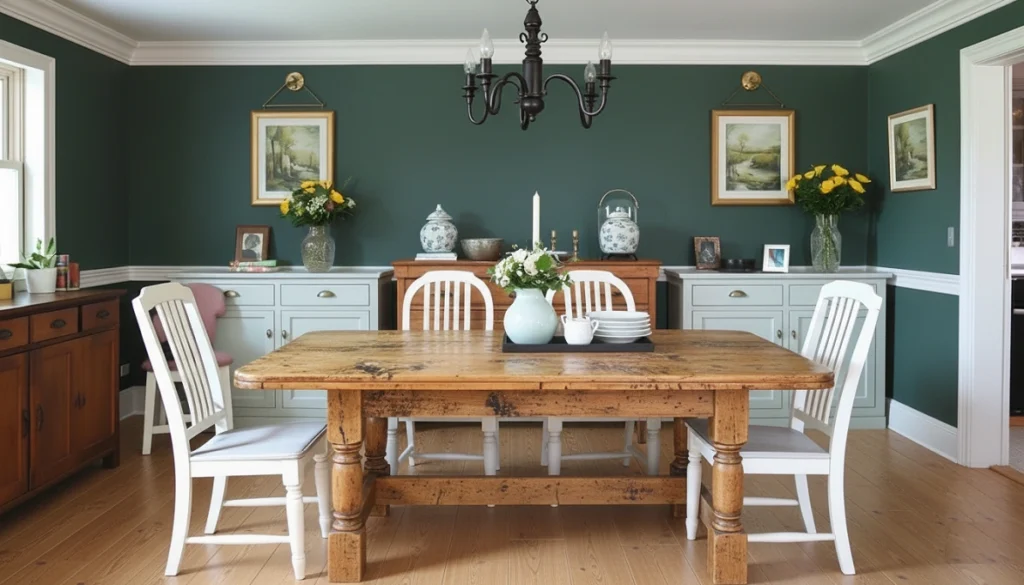
The trick isn’t sticking to a specific palette – it’s making sure your colors feel like they could exist in nature. That electric blue you see in some modern palettes? Nowhere in a meadow. That warm, greyish blue you get right before a storm? Perfect.
My go-to test: if I can’t imagine this color on something growing in a garden or weathering on a barn, I skip it.
Why I Always Push Natural Materials (And Why My Clients Thank Me Later)
I learned this lesson the hard way about eight years ago. Client wanted laminate that “looked like wood” because the real thing seemed impractical. Five years later, she called begging me to replace it with actual reclaimed oak. “I’m tired of pretending,” she said.
Natural materials age like good wine. That brass faucet that’s developing a patina? It’s getting more beautiful, not worse. The pine countertop that’s gained some knife marks? Those are proof the kitchen gets used for actual cooking.
I’ve gotten pretty good at finding affordable natural options. Estate sales are gold mines for solid wood furniture that just needs some love. Even Ikea’s pine pieces work if you let them age naturally instead of trying to keep them looking new. Take a look at this simple yet beautiful sideboard.
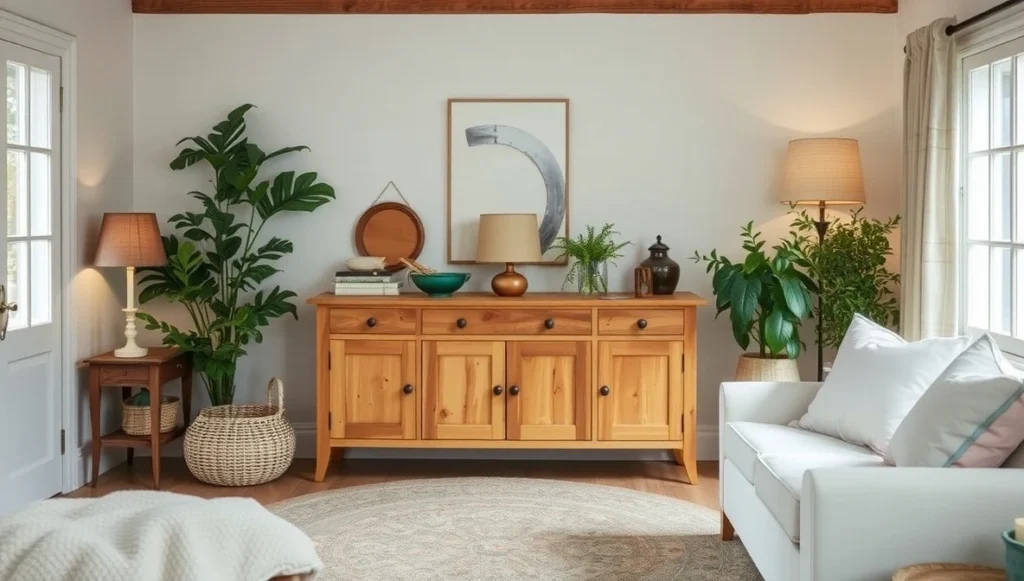
Stone is my splurge recommendation when budgets allow. Nothing – and I mean nothing – gives a space that permanent, rooted feeling like natural stone. Even small touches make a difference. I just finished a kitchen where we used river rock for a backsplash behind the stove. Cost maybe $200 in materials, but it looks like the cottage grew around it.
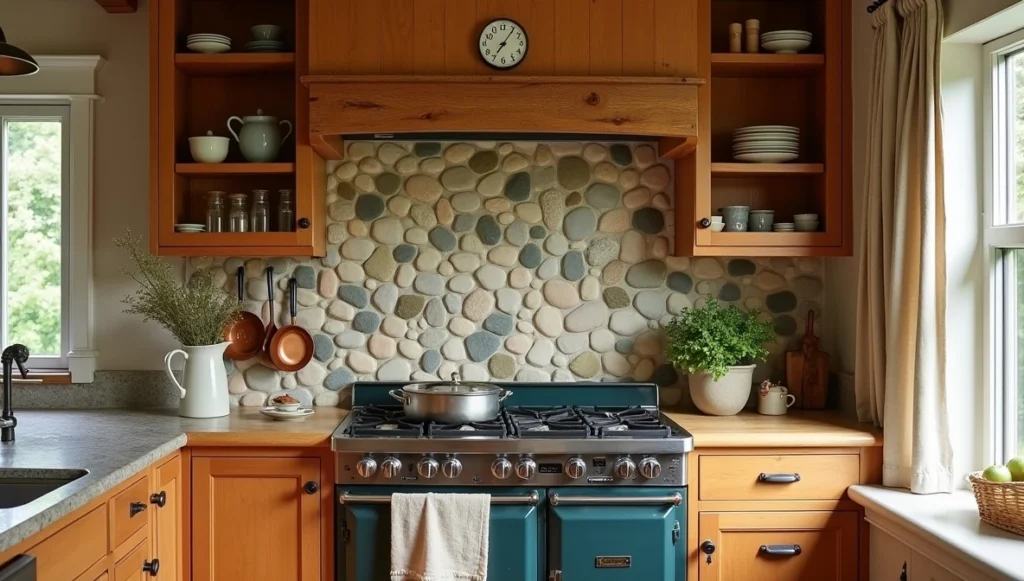
Furniture That Tells Stories (Even If You Made The Stories Up)
The best Cottagecore pieces look like they’ve lived a little. Not beat up – there’s a difference. I’m talking about furniture with character marks that make you wonder about its history.
That dining table with the mysterious ring stain? Someone’s grandmother probably set a hot pot there once. Keep the stain. Sand it smooth if it bothers you, but don’t try to erase it completely.
I spend a lot of time in antique shops, not because old automatically means better, but because aged pieces bring instant authenticity. Last month I found a pine armoire that had been painted three different times. You could see layers of paint wearing through at the handles and corners. Absolutely perfect.
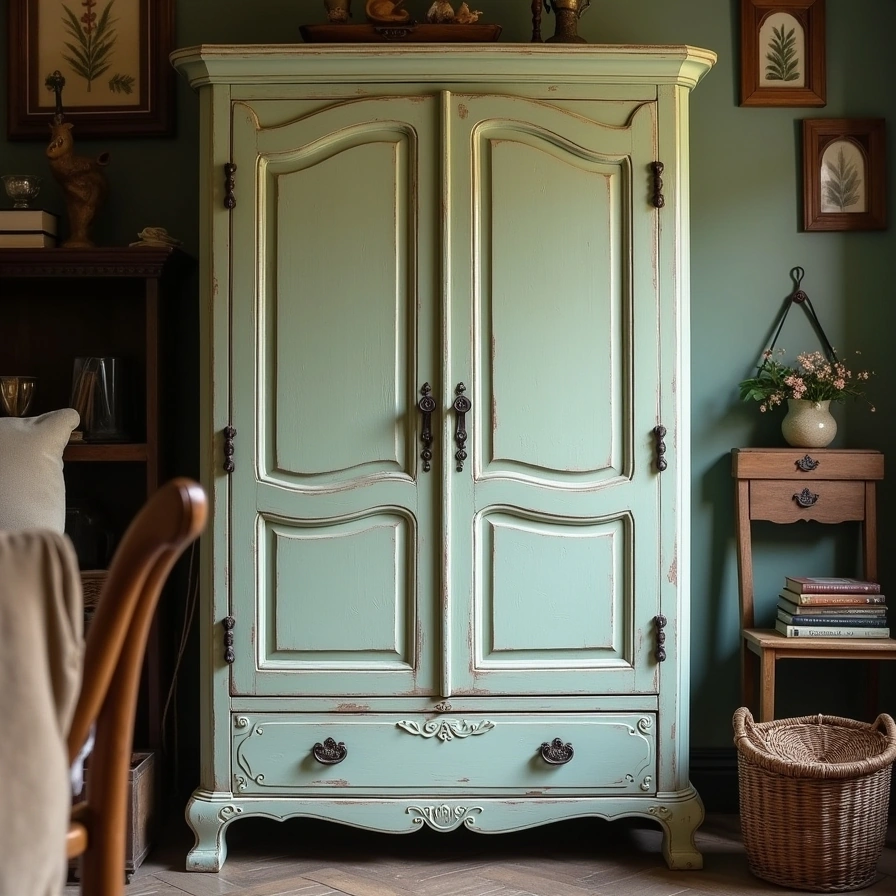
When buying new, I look for construction methods that echo old techniques. Dovetail joints, mortise and tenon connections, hand-forged hardware. These details matter more than most people realize.
Fabric Choices That Won’t Make You Crazy
Mixing patterns in Cottagecore spaces scares the hell out of most people. I get it. But there’s a secret: stick to a common color thread, and you can get away with almost anything.
I just finished a living room where we combined a large rose print, tiny gingham checks, and subtle herringbone wool. Sounds like a disaster, right? But they all shared this muted blue-grey undertone, so they played together beautifully.
Linen is expensive but worth it. It gets better with every wash, develops this perfect rumpled texture that screams “I live here and I’m comfortable.” Cotton voiles work great for curtains – they move in the breeze without being precious about it.
Here’s something nobody talks about: wool adds weight to a space. Not just physical weight, but emotional weight. A chunky wool throw changes the whole feel of a room. Makes it feel established, permanent.
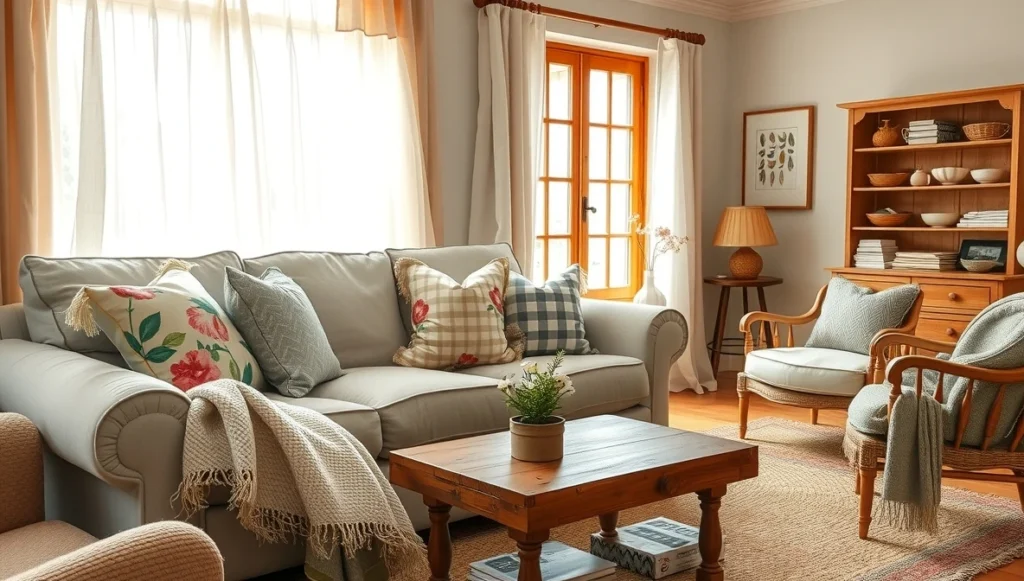
Plants: The Difference Between Cottagecore and Country Craft Store
Real Cottagecore spaces blur the line between inside and outside, but that doesn’t mean filling every corner with ferns (though ferns are nice too).
I tell clients to think seasonal. Spring bulbs forced indoors in January. Fresh herbs on kitchen windowsills. Dried hydrangeas in vintage mason jars when the garden goes dormant. It’s about the full cycle of plant life, not just the Instagram-perfect moments.
Window boxes work even in apartments. I helped one city client create a little herb garden on her fire escape – oregano, thyme, and sage in weathered wooden boxes. Cost maybe $50, but it connected her fourth-floor apartment to something real and growing.
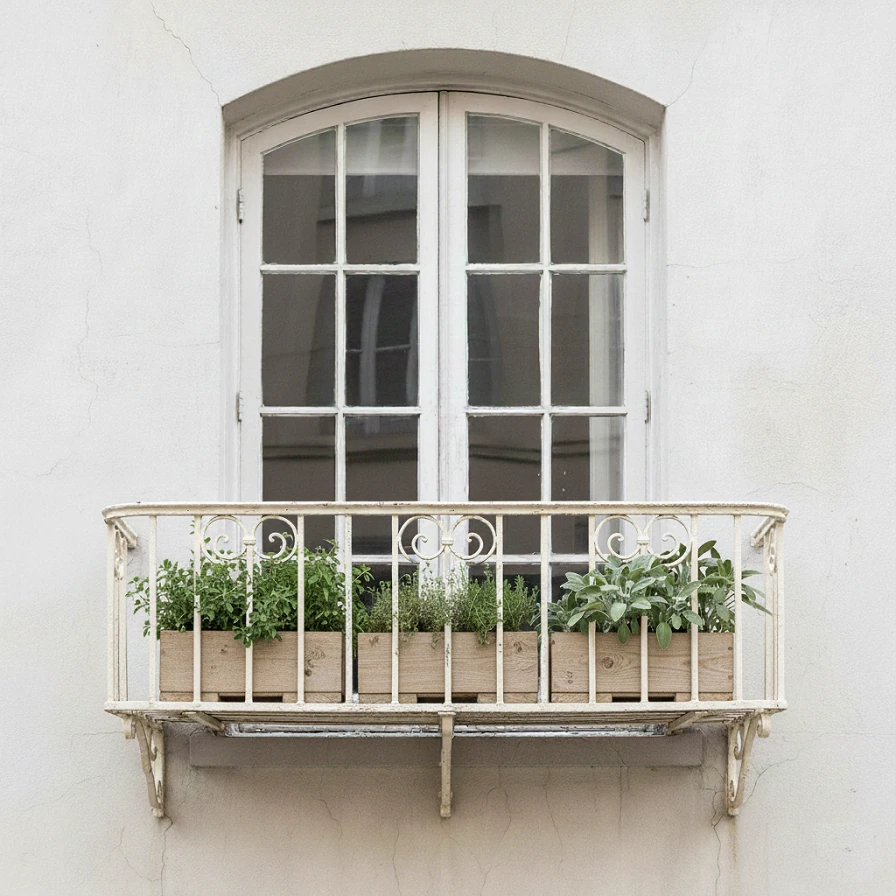
Don’t underestimate the power of branches. Just branches. I cut pussy willows every spring for my own house and clients always ask where I bought them. Nature is free, people.
Room-by-Room Reality Check
The Entry Hall Nobody Talks About
Most design articles skip this, but your entryway sets expectations for everything else. I put a weathered bench there – something sturdy enough to actually sit on while pulling off boots. Hooks on the wall for real coats, not just decorative scarves. A basket for mittens and dog leashes and all the random stuff that lives by the door.
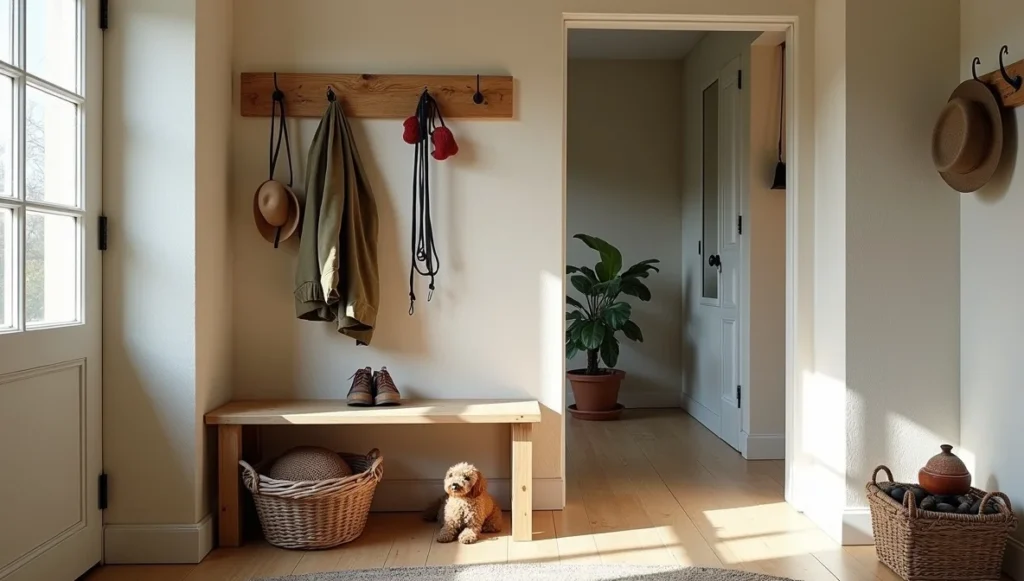
Kitchens That Work for Real Life
Open shelving looks great until you realize you have to keep your dishes perpetually clean. I compromise: some open, some closed. Display the pretty stuff, hide the everyday chaos.
Farmhouse sinks are worth the investment if you cook. I’ve never had a client regret going bigger on the sink. But that Instagram-famous marble? It stains. I prefer butcher block that accepts knife marks as part of its personality.
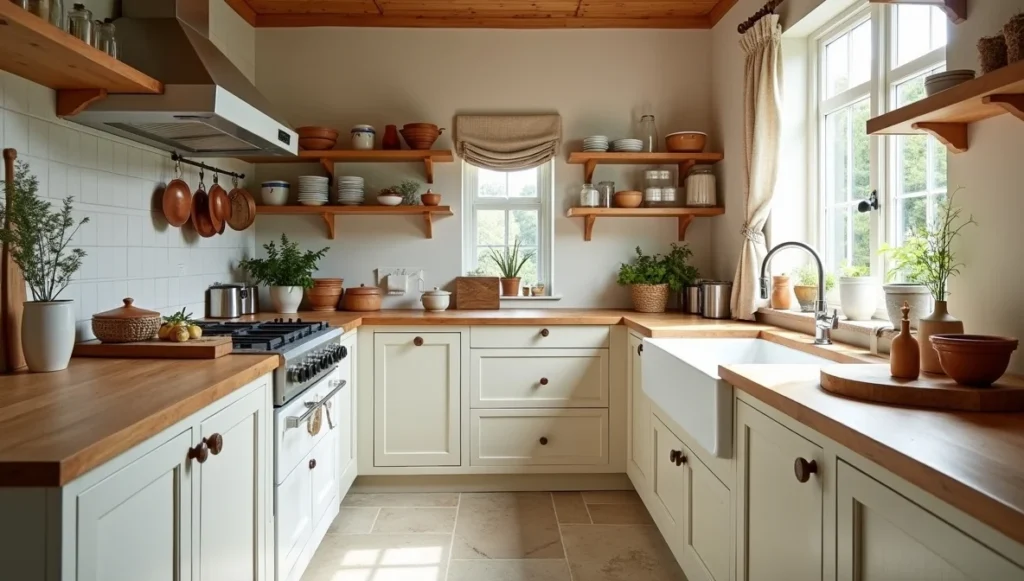
Living Rooms for Living
Books everywhere. Real books you’ve actually read, not decorative spines arranged by color. I arrange furniture so people can actually talk to each other, not just stare at the TV.
Good lighting matters more than expensive furniture. I layer different sources – table lamps, floor lamps, maybe some candles. Overhead lights stay off unless someone’s looking for contact lenses.
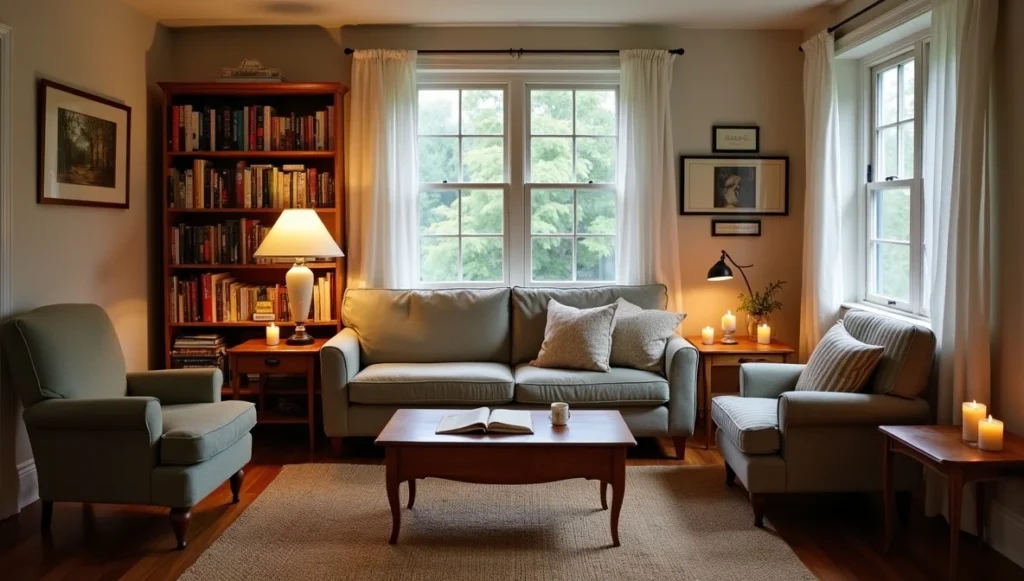
The Dining Room Revival
Nobody uses formal dining rooms anymore, so why pretend? I turn them into everyday eating spaces with tables sturdy enough for homework and puzzle projects. Chairs don’t have to match, but they should all be comfortable enough for lingering over coffee.
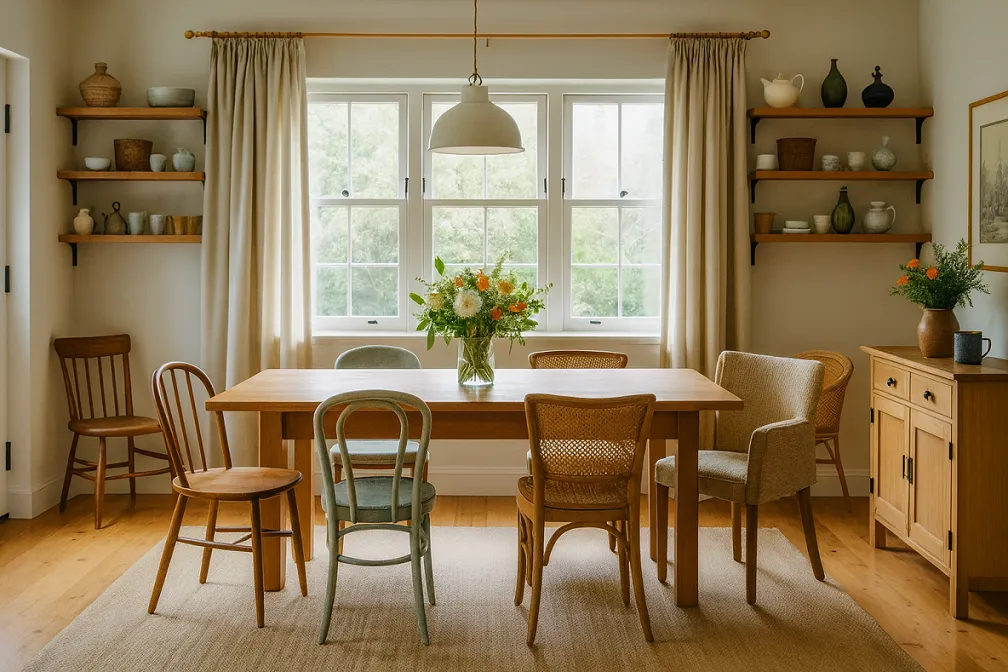
Bedrooms for Sleeping (and Reading)
Iron or wood bed frames, because they age better than upholstered ones. Layers of real cotton and linen bedding, because life’s too short for polyester sheets.
Reading chair by the window is non-negotiable. Even if the room is tiny. Even if you never read. It changes how the space feels.
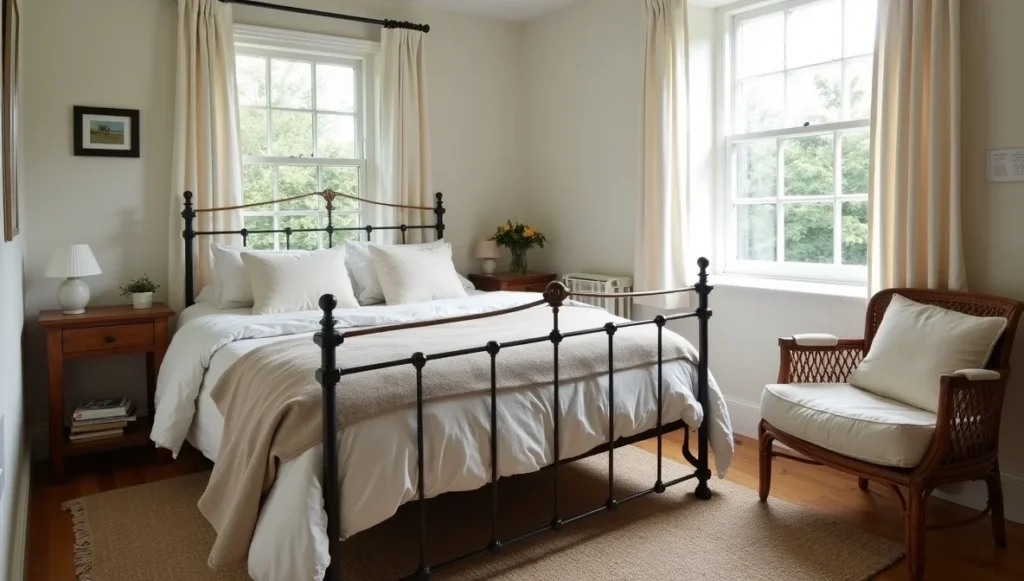
Bathrooms Worth Soaking In
Subway tile with dark grout hides soap scum better than white grout – learned this from experience. Pedestal sinks look great but offer zero storage, so plan accordingly.
Plants that like humidity: ferns, eucalyptus, anything that makes you feel like you’re bathing in a greenhouse.
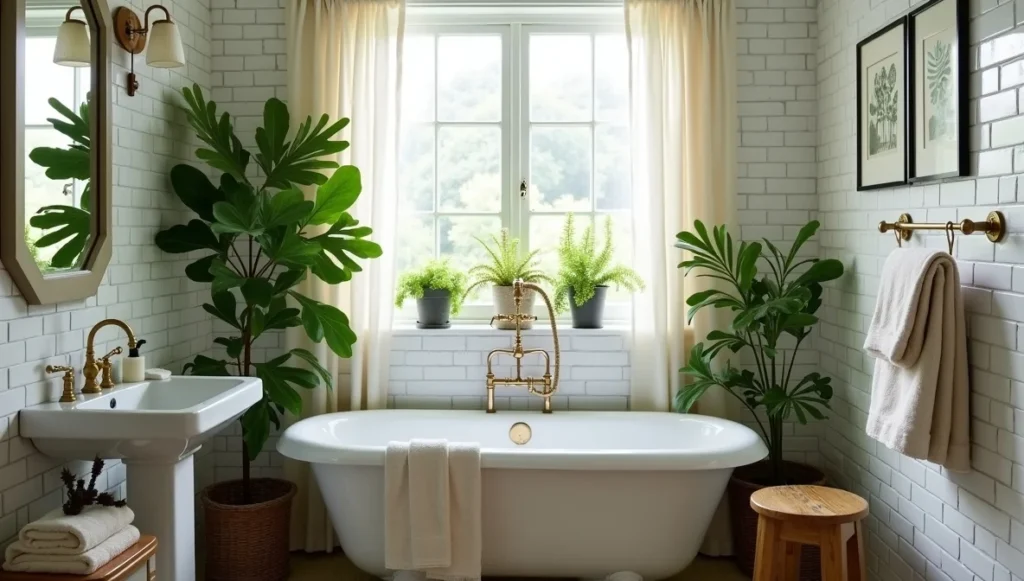
Home Offices That Don’t Suck
Solid wood desk if you can swing it. Something that won’t wobble when you type aggressively. Natural light from the left if you’re right-handed, right if you’re left-handed.
Books and supplies in vintage containers because they’re prettier than plastic organizers and work just as well.
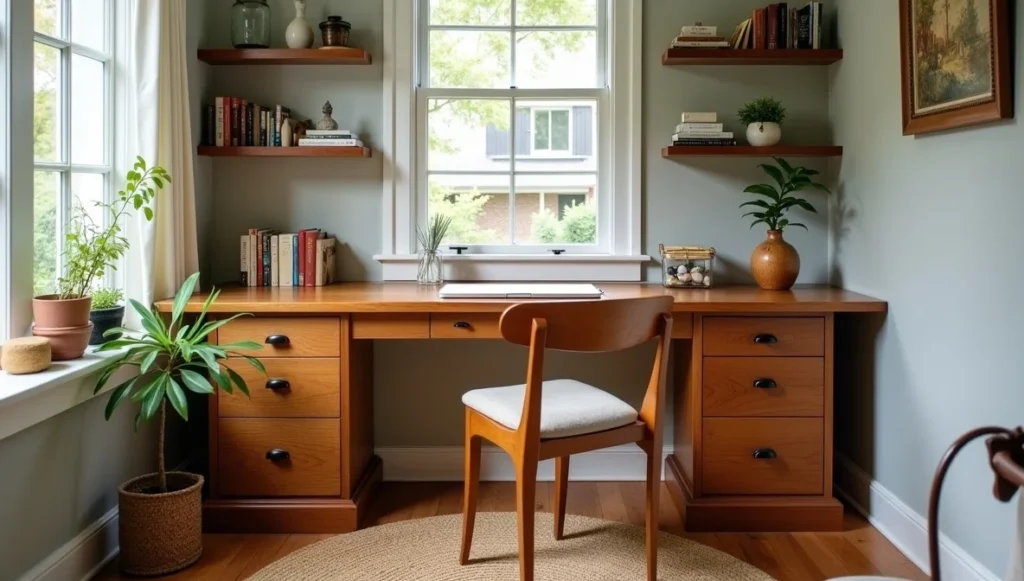
Mistakes I’ve Made (So You Don’t Have To)
Going Too Theme-Park My first Cottagecore project looked like a pioneer village gift shop. Every single item screamed “rustic charm” so loud you couldn’t hear yourself think. Balance is everything. Mix in some quieter pieces that just exist without making statements.
Ignoring Real Life That gorgeous white linen sofa? Beautiful in theory. In practice, it showed every coffee stain and dog hair. Form follows function, even in the coziest cottage.
Fake Aging Everything Distressed paint techniques rarely look authentic. Better to buy genuinely old pieces or let new ones age naturally. Time does better distressing than sandpaper.
Making It Work When Money’s Tight
Some of my best projects happened on shoestring budgets. Creativity beats cash every time.
Estate sales are treasure hunts. I found a solid oak dining table for $75 last month. It needed refinishing, but the bones were perfect. Thrift stores are hit-or-miss, but when you hit, you really hit.
DIY works for simple projects. Refinishing furniture, sewing basic curtains, building simple shelves. Don’t attempt anything structural unless you know what you’re doing.
Nature provides free decoration year-round. Branches, stones, pinecones, dried grasses. I have clients who spend nothing on accessories because they bring the outdoors in seasonally.
Why This Style Sticks
After nearly two decades designing homes, I’ve noticed something. Clients who choose Cottagecore design stay happy longer. They’re not constantly itching to redecorate because trends changed.
Maybe it’s because the style celebrates imperfection, so it doesn’t demand constant maintenance. Maybe it’s because natural materials actually improve with age instead of looking dated.
Or maybe it’s because Cottagecore spaces encourage slower living. When your home is set up for reading, cooking, and gathering rather than performing, you naturally spend more time doing those things.
Adapting for Real Modern Life
Nobody wants to live like it’s 1850, obviously. Smart home technology can hide behind rustic facades. Modern appliances come in vintage-inspired colors. You can have both convenience and character.
I just finished a project where we built the TV into an old armoire. Looks like antique furniture, functions like a modern media center. Best of both worlds.
Urban apartments work fine for Cottagecore principles. Window herb gardens, vintage textiles, warm lighting, natural materials where possible. The feeling matters more than square footage.
Seasonal Living
This might be my favorite aspect of Cottagecore design – how it celebrates changing seasons instead of fighting them. Summer brings fresh flowers and lightweight linens. Fall means dried arrangements and woolen throws. Winter calls for candlelight and heavier textures. Spring starts the cycle fresh.
This seasonal rotation keeps spaces feeling alive and connected to natural rhythms. It also means you’re constantly refreshing without major overhauls.
Final Thoughts From The Trenches
After hundreds of Cottagecore projects, here’s what I know for sure: the best spaces feel like they evolved naturally. They don’t scream about their design philosophy – they just quietly embody it.
Your home should make you want to put on soft pants and make tea. It should encourage long conversations and slow Sunday mornings. If a design choice doesn’t support that goal, skip it.
The world moves fast enough. Your home can be the place where you remember what matters: good food, comfortable spaces, people you love, and the quiet satisfaction of being somewhere that’s truly yours.
Trust your instincts over Instagram. Buy what you love, not what looks good in photos. And remember – the best-designed homes are the ones that get lived in fully, imperfections and all.
